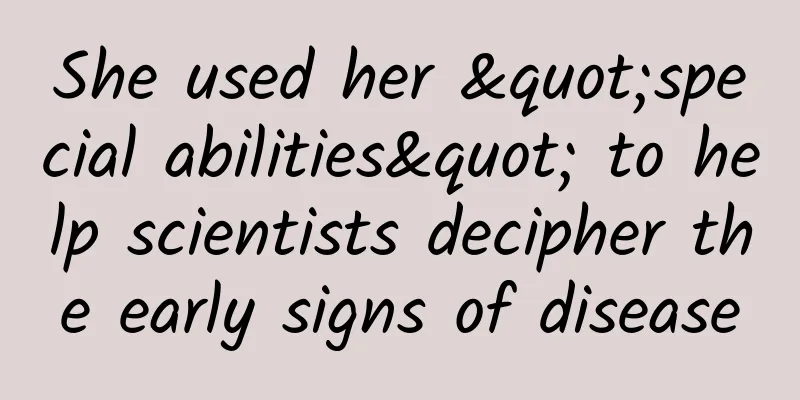She used her "special abilities" to help scientists decipher the early signs of disease

|
As we all know, dogs have a strong sense of smell. Medical sniffer dogs have successfully sniffed out various cancers, chronic diseases, Parkinson's disease, etc. in humans. The sense of smell is so erratic and mysterious. It seems to be connected to intuition. It is accurate and powerful, but difficult to verify and repeat. There are also very few people with super sense of smell. They not only do what dogs do, but also do things that dogs cannot do. Written by | BiPuXianren At the beginning of the COVID-19 pandemic, many Western countries introduced “COVID-19 sniffer dogs” to search for carriers of SARS-CoV-2. According to reports, some people who had no symptoms and whose nucleic acid tests were negative were “diagnosed” as virus carriers by sniffer dogs, and a few days later, they began to show symptoms of Covid-19. [1] Studies have shown that specially trained dogs can accurately identify 97% of people who test positive for COVID-19 through PCR, and can also accurately identify infected people with negative PCR results with 91% accuracy. As a result, some people lament that nasal and throat swabs are not as good as swabs taken by well-trained dogs. [2] Figure 1. COVID-19 sniffer dog Tala on duty[1] There are as many as 300 million olfactory receptors in the nasal cavity, and the volume of the olfactory bulb in the brain is 30 times higher than that of humans. The gifted dog swabs have long been shining in the medical field. According to many research papers and news reports, medical sniffer dogs have successfully sniffed out various human cancers, chronic diseases, Parkinson's disease... Scientists say we don’t know exactly what the dogs are smelling, but at a basic physiological level, cancer or infection can alter human metabolism, and there are very subtle differences in smell between sick and healthy individuals, so subtle that they cannot even be detected using precise chemical analysis, such as gas chromatography-mass spectrometry. Dogs are able to smell the “smell of disease,” to detect that subtle difference, that unique smell signature/pattern of the patient, and to respond to it. [3] For example, the body odor emitted by a certain part of the human skin is composed of compounds A, B, C, and D in a specific proportion. If you take out any one of these four substances and let a dog smell it, it will not have any reaction. However, the ABCD body odor emitted by a sick individual is different from that of a healthy person. It may be that the content of component B is too high. Then, if you let a dog smell the patient, it can sensitively identify that the ABCD body odor has characteristics different from those of ordinary people and give feedback. Many scientific research teams are trying to use dogs' sense of smell to analyze and deconstruct the smell of disease, and accurately determine which one or which components of ABCD are abnormal and cause the abnormal smell. When it comes to identifying patients by smell, humans are indeed far inferior to dogs. But there are a few super smellers who can really do what dogs do, and at the same time do things that dogs cannot do. Musk smells so good Sending me Parkinson's disease signals The human brain begins building a library of smells in infancy and continues to develop into adulthood. For people with hereditary hyperosmia, this library can be very large and sophisticated, so they have a superb ability to detect and distinguish smells. Joy Milne, a Scotswoman in her 70s, was a nurse and suffers from hereditary hypersmell. She discovered this superpower when she was a child. Joy's grandmother not only passed on her super sense of smell, which she inherited from her mother, to her granddaughter, but also trained little Joy to identify the characteristics of odors, just as her mother trained herself. As a nurse, Joy has built up a rich clinical odor library to sniff out disease. When her husband, Les, was diagnosed with Parkinson’s disease about three decades ago, Joy realized that the musky odor she had smelled for years on the back of his neck was a warning sign—she also smelled it in other Parkinson’s patients. Figure 2. Mr. and Mrs. Milne on their wedding day[4] In 2015, Rice passed away due to illness. Since then, Nurse Milne has begun to fulfill the promise she made to her husband before his death: to contribute to the diagnosis and treatment of Parkinson's disease. She entered and "lived" in the laboratory of the School of Chemistry at the University of Manchester, working with T-shirts and used gauze worn by Parkinson's patients, sniffing the sebum in them. Yes, it is the oil secreted by the sebaceous glands in the skin. Sebum is a waxy, lipid-rich biological fluid that emits body odor, which in scientific terms is volatile organic compounds (VOCs) produced by human metabolism. Parkinson's patients have abnormal sebum metabolism (and this abnormality changes as the disease progresses). Therefore, sebum contains unique biomarkers, which evaporate into the nasal cavity of people with super smell and become the "Parkinson's disease smell." [5] Milne said that the musky body odor of patients was concentrated in areas with high sebum secretion, namely the upper back and forehead, but not in the armpits. In addition, she could detect whether someone had the disease with 95% accuracy. [6] Figure 3. Milne at work[7] Perdita Barran, head of the laboratory and director of the Mass Spectrometry Department of the School of Chemistry, used Milne's sense of smell to conduct a dual chemical (thermal desorption-gas chromatography-mass spectrometry) and olfactory analysis of sebum volatiles collected from patients and healthy people. After further data analysis, she finally identified a group of volatile metabolites associated with Parkinson's disease: perillic aldehyde, hippuric acid, eicosane, and octadecanal. [8] Compared with healthy people, Parkinson's patients have significantly increased levels of eicosane in sebum, significantly lower levels of perillaldehyde, and no obvious increase in hippuric acid and octadecanal. When he sniffed this unusual combination of metabolites, Milne could detect a strong, musky aroma. Sweet biscuits, spreading fermentation Sleep disorders come earlier As mentioned earlier, the abnormal sebum metabolism of Parkinson's patients changes as the disease progresses. Milne's goal is not just to identify patients who can be seen by everyone. She hopes to help doctors and scientists optimize early diagnosis methods so that they can diagnose an early Parkinson's patient who has no typical symptoms or even no abnormalities. Milne began working with Balan’s colleague Drupad Trivedi, a metabolomics expert at the University of Manchester’s Institute of Biotechnology. Parkinson's disease is more common in middle-aged and elderly people. It is the second most common neurodegenerative disease, affecting 6 million patients worldwide. Typical symptoms include movement dysfunctions such as resting tremor, muscle rigidity, bradykinesia and postural balance disorders, which generally appear in the middle and late stages; before that, patients will experience a prodromal period lasting several years. People with prodromal Parkinson's disease do not yet have motor dysfunction, but may show some seemingly unrelated signs, including changes in body odor, changes in skin health, decreased sense of smell, constipation and rapid eye movement sleep behavior disorder (RBD). During rapid eye movement (REM) sleep, the body of a normal person is paralyzed to prevent them from putting their actions in dreams into practice; but some people are not restrained by this and will make violent movements in their sleep, which is RBD. According to Trivedi, at least 70% of these people will develop neurological diseases. Milne recalls her husband's early symptoms, one of which was RBD. "I noticed he had a strange odor at the time, but I didn't think much of it; later he developed full-blown Parkinson's and his body odor became a strong musky smell." Figure 4. Monitoring and recording of RBD episodes[9] Trivedi and Milne tried to decipher the body odor of prodromal Parkinson's patients. The research team recruited Parkinson's disease patients, RBD patients and healthy volunteers to participate in the experiment, collected sebum samples from their upper back area, and compared the volatile metabolite levels of sebum through chemical analysis and machine learning methods. Combined with Milne's olfactory report, they finally came up with 18 VOC characteristics of RBD patients, proving that the chemical characteristics of their metabolites were between the healthy group and the Parkinson's disease group. [10] It should be pointed out here that the RBD patients participating in the project did not have motor dysfunction, and the research team was unable to determine whether they were prodromal Parkinson's patients. To Milne, the Parkinson's samples smelled musky, and the RBD group smelled biscuit sweet overall, but three of the RBD samples seemed to have some Parkinson's mixed in. Subsequent clinical follow-up showed that 2 of the 3 suspected RBD patients developed typical signs of Parkinson's disease. “It’s really cool to be able to smell the disease and deconstruct it in such detail,” Trivedi said. “From an analytical chemistry perspective, it means you’ve identified very consistent volatile signatures, and the super nose picked up on those as well. Of course, not everyone with RBD will develop Parkinson’s, so we need to do more research to determine the differences in the body odor signatures between people with prodromal Parkinson’s and those with RBD who don’t develop Parkinson’s.” Academic peers praised the work of Trivedi and others: “Neurodegenerative diseases are difficult to diagnose, especially in the early stages. This study confirms that there are detectable changes in the VOC characteristics of early Parkinson’s disease. If we can diagnose Parkinson’s disease early, we may be able to effectively slow its progression or even treat this devastating disease.”[11] The gray matter is burning and the pain is unbearable Signs of sensitivity during pregnancy, the beauty of training How did humans develop a super sense of smell and what is the underlying mechanism? Scientists have yet to gain a deep understanding of this. However, based on years of research and observation, they have attempted to explain the causes of olfactory hypersensitivity from four dimensions. Genetics Studies have shown that certain genetic factors may enhance the sense of smell, such as duplication or overexpression of the KAL1 gene, or mutations in the sodium ion channel Nav1.7 encoded by the SCN9A gene. KAL1 gene expression produces the glycoprotein anosmin-1, which is important for the growth and migration of neurons in the olfactory system. Its absence can lead to anosmia, while its overexpression may be associated with olfactory hypersensitivity. [12] The SCN9A gene is also known as the pain gene. The voltage-gated sodium channel Nav1.7 it encodes is like a pain switch. If the switch is abnormal, the human body will become completely insensitive to pain or extremely afraid of pain. Those who lack pain perception will often also lose their sense of smell, while those who are extremely afraid of pain may gain a super sense of smell. [13] Other studies have shown that people with the genetic disease Lowe syndrome (oculocerebrorenal syndrome) due to mutations in the OCRL gene may also be born with a good sense of smell.[14] Health problems and pregnancy Many studies have reported associations between various health conditions and hypersmell. These conditions include Lyme disease, migraines, fluid disorders, hormone deficiencies, and the use of certain medications. Although the exact mechanism by which they enhance the sense of smell is unclear, it is reasonable to speculate that they indirectly affect the signals produced by odor receptors by affecting the body's electrolytes. Many pregnant women claim that certain smells that they used to be accustomed to suddenly become unpleasant. Previous studies have reported that about two-thirds of pregnant women feel that their sense of smell is stronger than that of ordinary people. Scholars reviewed dozens of papers on how pregnancy changes the sense of smell and concluded that pregnant women’s overall sense of smell is not enhanced, but they become more sensitive to certain smells. There is insufficient evidence to prove that they can identify smells that they could not identify before.[15] Increased sense of smell during pregnancy is generally a temporary rather than permanent change. Brain Differences and Memory In a study published in 2019, scientists attempted to uncover the extraordinary features of the brains of super smellers. They recruited 25 men who reported having a super sense of smell and 20 normal men, and compared the volume of gray matter in the olfactory-related brain regions using brain scans. [16] The results showed that in the brains of super smellers, two key areas responsible for collecting odor information and learning and memorizing odors have larger volumes of gray matter and stronger neural activity. Of course, the research team cannot determine whether these differences are genetic or acquired. Sometimes, an allergic sense of smell is closely associated with specific memories, especially negative memories. A team once conducted a survey on people who considered themselves to have an extraordinary sense of smell to understand the importance of their "olfactory memory." The survey results showed that the respondents associated the smell of perfume, sweat, etc. with specific negative consequences and unpleasant memories. For them, these environmental smells would cause annoyance and disgust. [17] Of course, this survey is not comprehensive enough, and we don't know whether the respondents' noses are sensitive to all kinds of smells or only good at responding to negative memories. Other studies have made similar findings: some people’s sensitivity to specific smells, such as formaldehyde and pyridine, is associated with negative experiences, and their “super sense of smell” develops based on negative experiences in work situations. Deliberate Training Can a super sense of smell be trained? If so, how long will the superpower last? British scientists have tried to "train" the sense of smell. They recruited more than 200 volunteers and asked them to smell different concentrations of odors according to their requirements using a custom-made odor distribution device. The device can emit 8 concentration levels of phenylethyl alcohol (rose smell) or eucalyptus oil (mint smell), ranging from the lowest level that is almost imperceptible to the highest level that is extremely strong. [18] Each person must first take a sniff test to measure the lowest concentration level they can smell. The average of all the test results will give the "lowest concentration threshold that ordinary people can smell." If someone can smell a concentration 3 levels lower than the average threshold, it means he is hypersmia. In a subsequent single test, 2% of the participants stood out and demonstrated a super sense of smell. Another 10% of people had a brief period of super sense of smell during the repeated tests once a week for 10 weeks, but then quickly returned to normal. There is reason to believe that training can lead to an extraordinary sense of smell. Aren’t those professional sommeliers and perfumers able to penetrate the most subtle flavors through training? In fact, it is not uncommon for people with anosmia to recover their sense of smell through training. [19] Therefore, deliberate training may also cultivate a unique ability like Milne to diagnose certain diseases. References [1] https://www.theguardian.com/world/2021/may/24/faster-than-pcr-test-dogs-detect-covid-coronavirus-london-bmj [2] https://journals.plos.org/plosone/article?id=10.1371/journal.pone.0268382#sec014 [3] https://www.nature.com/articles/d41586-022-01629-8 [4] https://www.bbc.com/news/uk-scotland-62795737 [5] https://www.ncbi.nlm.nih.gov/pmc/articles/PMC7908024/ [6] https://www.smithsonianmag.com/smart-news/woman-who-can-smell-parkinsons-helps-develop-a-skin-swab-diagnostic-test-180980741/ [7] https://www.bbc.com/news/uk-scotland-47627179 [8] https://www.ncbi.nlm.nih.gov/pmc/articles/PMC6487537/ [9] https://www.lemonde.fr/blog/realitesbiomedicales/tag/rem-sleep-behavior-disorder/ [10] https://www.biorxiv.org/content/10.1101/2023.03.01.530578v1.full [11] https://www.the-scientist.com/news-opinion/disease-scent-signatures-disclose-what-the-nose-knows-71161 [12] https://www.ncbi.nlm.nih.gov/pmc/articles/PMC4412513/ [13] https://onlinelibrary.wiley.com/doi/full/10.1002/ejp.1272 [14] https://pubmed.ncbi.nlm.nih.gov/25480730/ [15] https://www.ncbi.nlm.nih.gov/pmc/articles/PMC3915141/ [16] https://link.springer.com/article/10.1007/s11682-018-0008-9 [17] https://journals.sagepub.com/doi/10.1177/1359105313481080 [18] https://www.cambridge.org/core/journals/journal-of-laryngology-and-otology/article/abs/superosmic phenomenon/4D0D83E5A49D994EC6E3C6FD19AC17AE [19] https://www.fifthsense.org.uk/stories/ This article is supported by the Science Popularization China Starry Sky Project Produced by: China Association for Science and Technology Department of Science Popularization Producer: China Science and Technology Press Co., Ltd., Beijing Zhongke Xinghe Culture Media Co., Ltd. Special Tips 1. Go to the "Featured Column" at the bottom of the menu of the "Fanpu" WeChat public account to read a series of popular science articles on different topics. 2. Fanpu provides a function to search articles by month. Follow the official account and reply with the four-digit year + month, such as "1903", to get the article index for March 2019, and so on. Copyright statement: Personal forwarding is welcome. Any form of media or organization is not allowed to reprint or excerpt without authorization. For reprint authorization, please contact the backstage of the "Fanpu" WeChat public account. |
<<: Meteorological satellite images contain the latest technology for predicting disasters!
>>: Little-known facts about teeth cleaning | 90% of people don’t know!!
Recommend
Analysis of the principle of attribute animation mechanism
[[437959]] This article is reprinted from the WeC...
In the future, this material will be used to build houses, which will be warm in winter and cool in summer without air conditioning.
Produced by: Science Popularization China Produce...
Subvert your cognition! To prevent Alzheimer's disease, you may only need one shot of vaccine? !
As the aging process of the population accelerate...
What kind of methodology can continuously create popular marketing products?
For most marketers, screen swiping is something t...
MIUI6 has caused controversy. Where will the customized system go in the future?
MIUI, the "best third-party customized Andro...
What exactly is PCDN? Is it a disruptive "black technology"?
What is PCDN? CDN (Content Distribution Network) ...
This is what the Nike smart running shoes that sell for 5,000 yuan look like after being disassembled
Last December, the world's first self-lacing ...
These things you use every day were originally designed for people with disabilities
We live in a world that is largely designed for t...
The latest update on Shanghai’s return home policy in 2022: What proof is required? Do I need to be quarantined after the lockdown is lifted?
At present, the epidemic situation in Shanghai ha...
Baidu search promotion optimization detailed explanation!
Today, I will share with you the introductory kno...
In the spring with catkins all over the sky, please be careful of allergies
It is April again, the spring has come. After the...
The Fantastic Journey of Sinus Cancer: A Battle with the "Microcosmos"
Have you ever wondered what secrets are hidden in...
Do girls have any physiological reactions when kissing? How does it feel when a girl kisses you?
Kissing is a way for boyfriends and girlfriends t...
This magic skill may only be used by 1% of content operators, but it can help you get twice the result with half the effort
"Baidu Index is a data sharing platform base...
How much does it cost to renovate a second-hand house in Lanzhou? How much does it cost per square meter to renovate an old house?
Unlike new houses, second-hand houses require mor...









